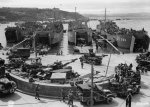This year marks the 75th anniversary of the D-Day invasion of 1944. Because of this, I'm going to recycle my WWII Daily posts from a few years ago to commemorate these brave men starting today (June 1) as a lead up to the largest seaborne invasion in history.
June 1, 1944: In the UK, preparations for the upcoming D-Day invasion reach a fevered pitch as Allied commanders meet to consider weather forecast for Normandy invasion.
Admiral Bertram Ramsay assumes operational command of Allied naval forces for Operation Neptune, the amphibious phase of the Normandy invasion. Both Allied Eastern and Western Naval Task Force assault forces begin loading and assembling.
A Daily Telegraph crossword puzzle the solution to 15 Down was "Neptune", the codename for the D-Day naval assault.
In the evening, the BBC broadcasts the first code message intended as a warning to the French resistance that a invasion is imminent - the opening lines of the 1866 Verlaine poem "Chanson d'Automne" are to indicate the start of D-Day operations. The first three lines of the poem, "Les sanglots longs / des violons / de l'automne" ("Long sobs of autumn violins"), mean that Operation Overlord is to start within two weeks. The next set of lines, "Blessent mon coeur / d'une langueur / monotone" ("wound my heart with a monotonous languor"), mean that it will start within 48 hours and that the resistance should begin sabotage operations, especially on the French railroad system; these last lines were broadcast on June 5 at 11:15PM. The Germans appreciate the significance of the message and alert some units in occupied France.
Over northwest Europe, US 9th Air Force attacks airfields and coastal installations with 100 bombers. RAF Bomber Command sends 109 aircraft to attack Ferme-D'Urville overnight and 58 aircraft to attack railway at Saumur overnight. RAF Bomber Command sends 40 aircraft on special operations with supplies and agents for Resistance forces overnight.
Pictured: US LSTs 284, 380, 382, and 499 loading men, vehicles, and supplies for the upcoming Normandy Invasion in Brixham Harbor, Devon, England, Jun 1 1944. Note wings and fuselage of an Aeronca L-3 Grasshopper observation aircraft on a CCKW truck; Tightly packed in British-built LCA in preparation for transfer to larger transport ships, 2nd Ranger Infantry Battalion elements sit waiting in Weymouth Harbor, England, June 1, 1944; Gasoline drums ready for shipment to supply vehicles on D-Day



June 1, 1944: In the UK, preparations for the upcoming D-Day invasion reach a fevered pitch as Allied commanders meet to consider weather forecast for Normandy invasion.
Admiral Bertram Ramsay assumes operational command of Allied naval forces for Operation Neptune, the amphibious phase of the Normandy invasion. Both Allied Eastern and Western Naval Task Force assault forces begin loading and assembling.
A Daily Telegraph crossword puzzle the solution to 15 Down was "Neptune", the codename for the D-Day naval assault.
In the evening, the BBC broadcasts the first code message intended as a warning to the French resistance that a invasion is imminent - the opening lines of the 1866 Verlaine poem "Chanson d'Automne" are to indicate the start of D-Day operations. The first three lines of the poem, "Les sanglots longs / des violons / de l'automne" ("Long sobs of autumn violins"), mean that Operation Overlord is to start within two weeks. The next set of lines, "Blessent mon coeur / d'une langueur / monotone" ("wound my heart with a monotonous languor"), mean that it will start within 48 hours and that the resistance should begin sabotage operations, especially on the French railroad system; these last lines were broadcast on June 5 at 11:15PM. The Germans appreciate the significance of the message and alert some units in occupied France.
Over northwest Europe, US 9th Air Force attacks airfields and coastal installations with 100 bombers. RAF Bomber Command sends 109 aircraft to attack Ferme-D'Urville overnight and 58 aircraft to attack railway at Saumur overnight. RAF Bomber Command sends 40 aircraft on special operations with supplies and agents for Resistance forces overnight.
Pictured: US LSTs 284, 380, 382, and 499 loading men, vehicles, and supplies for the upcoming Normandy Invasion in Brixham Harbor, Devon, England, Jun 1 1944. Note wings and fuselage of an Aeronca L-3 Grasshopper observation aircraft on a CCKW truck; Tightly packed in British-built LCA in preparation for transfer to larger transport ships, 2nd Ranger Infantry Battalion elements sit waiting in Weymouth Harbor, England, June 1, 1944; Gasoline drums ready for shipment to supply vehicles on D-Day



























